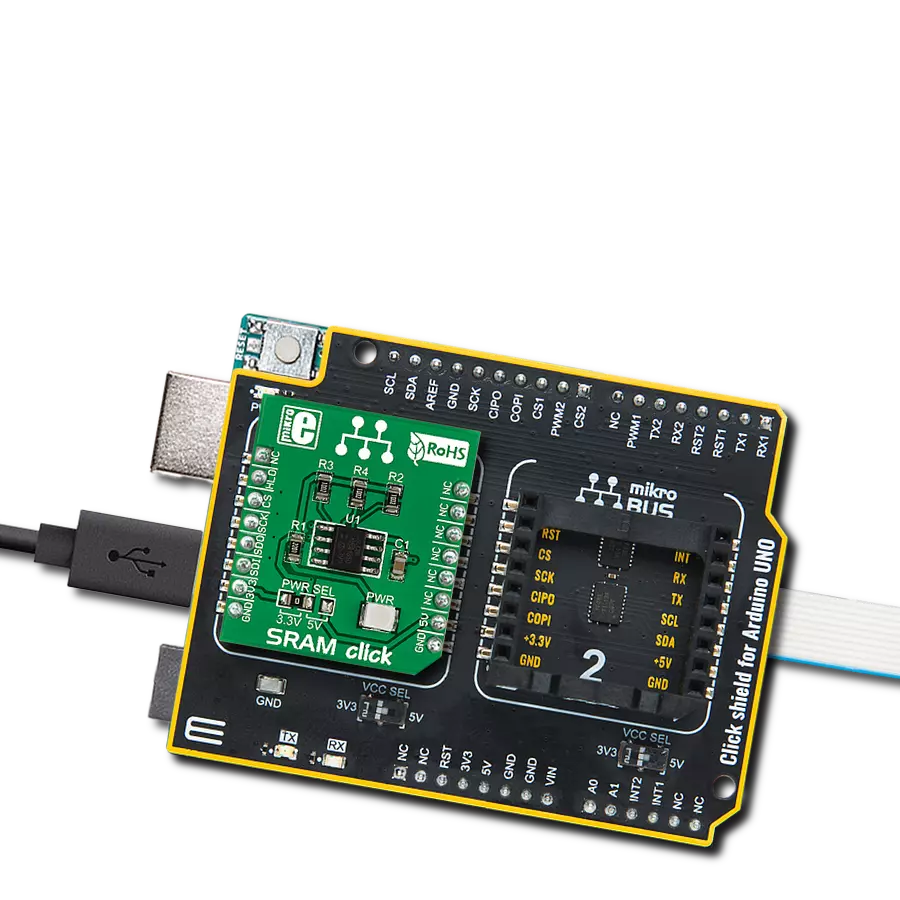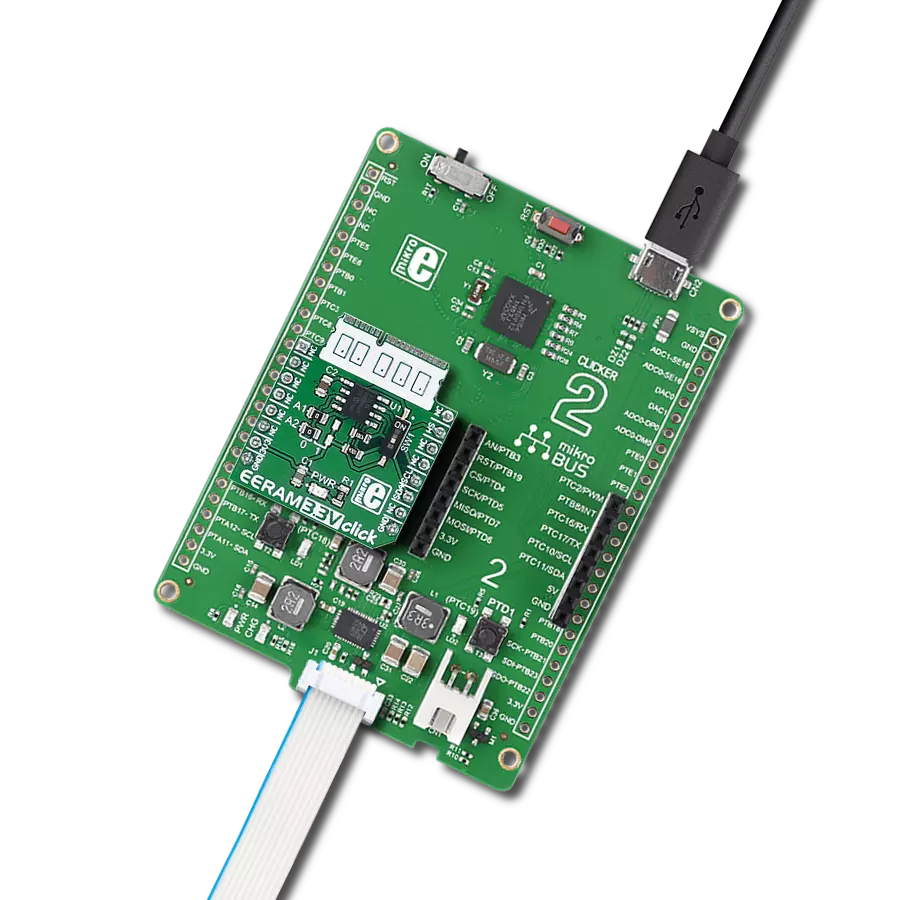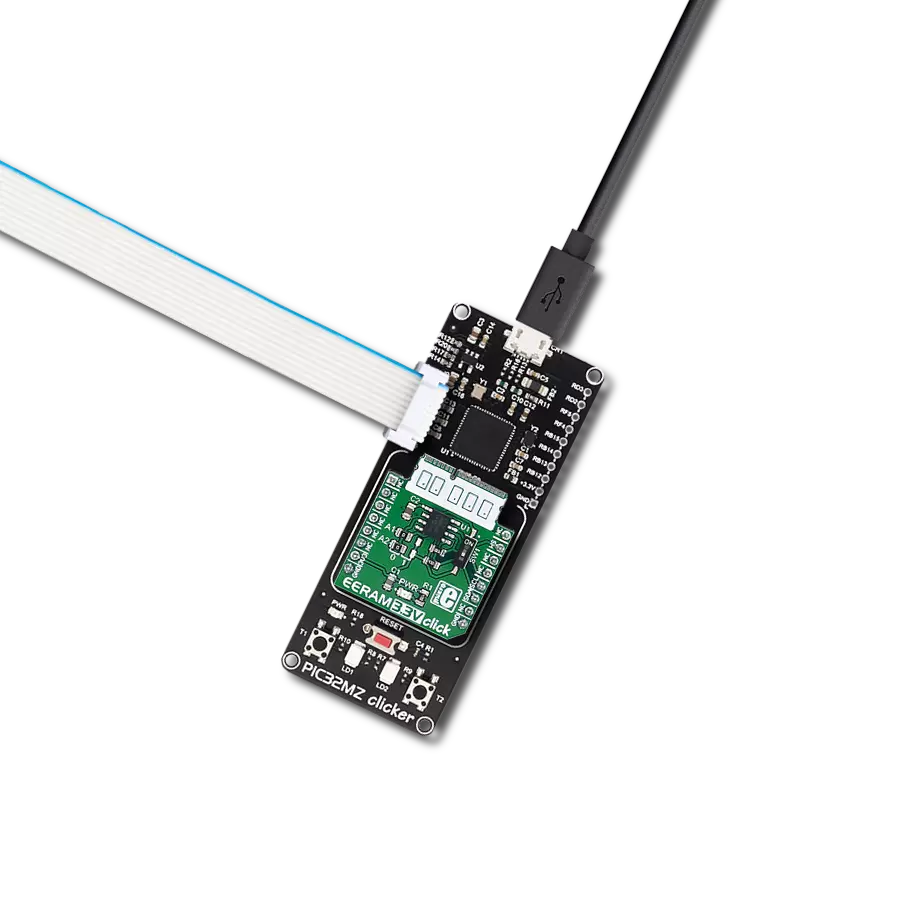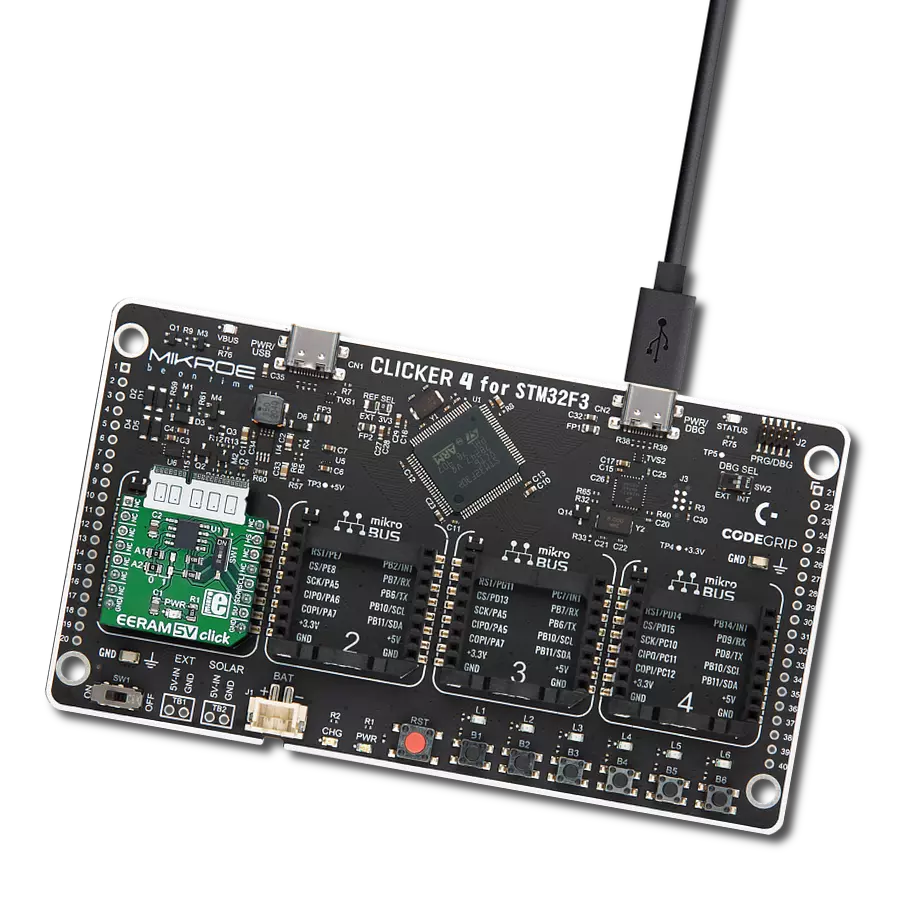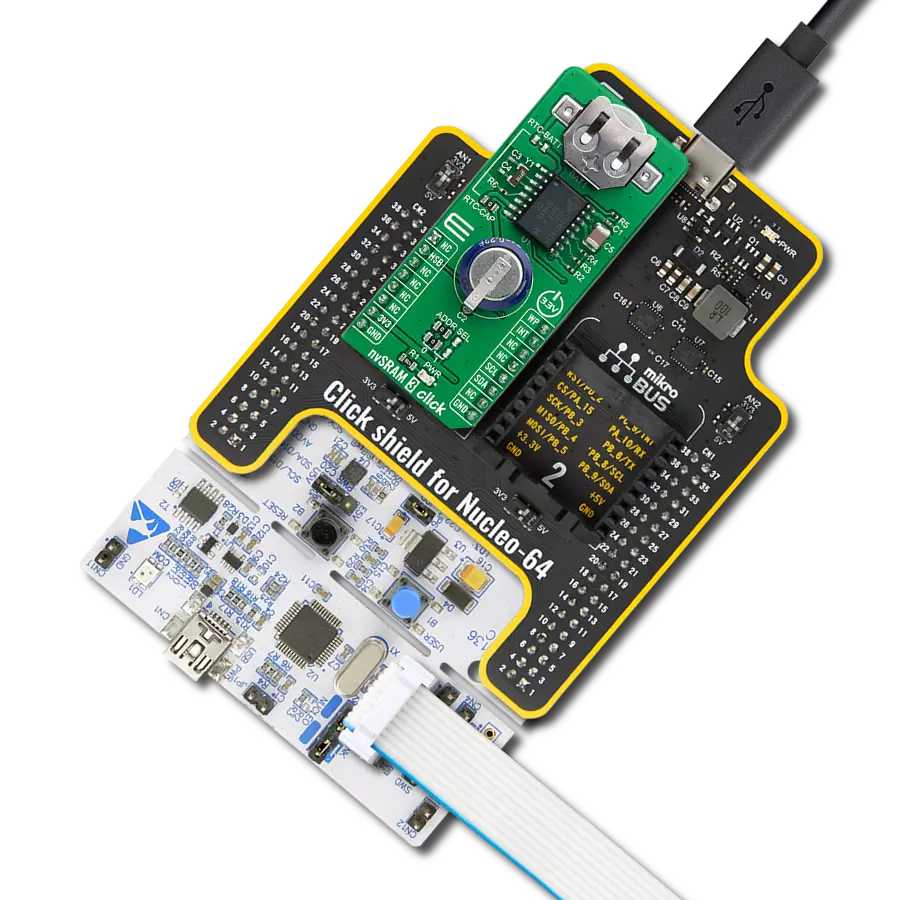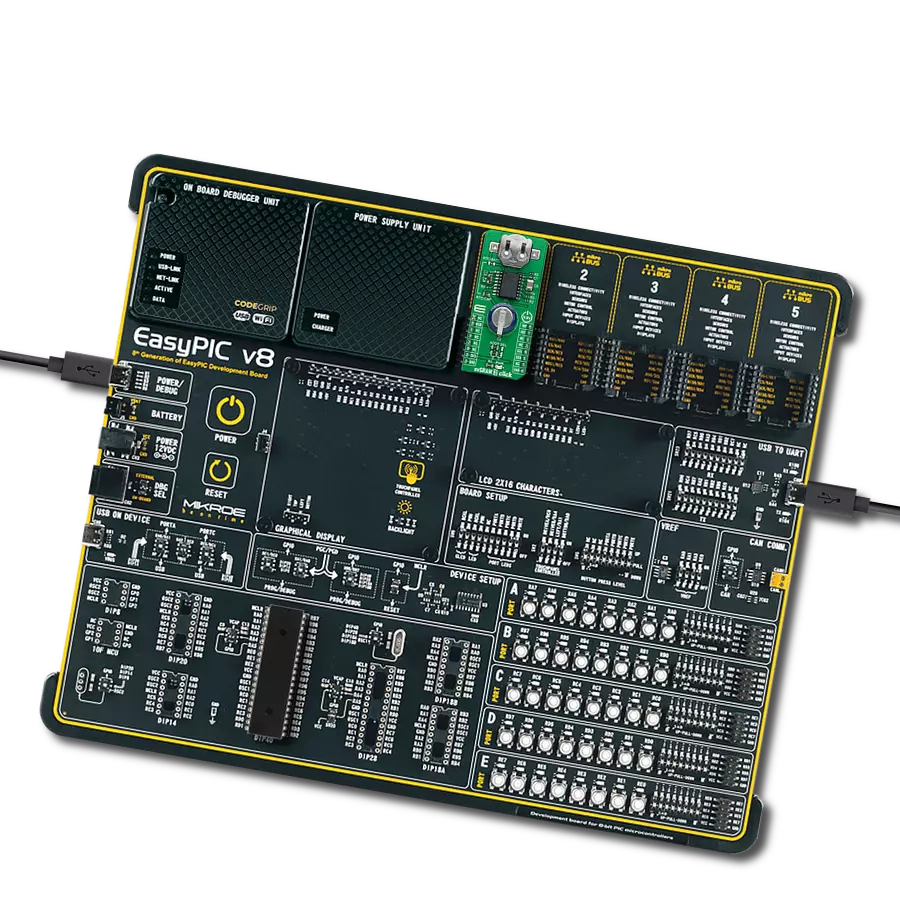Our nvSRAM solution preserves your critical data, performs at lightning speed, and ensures data persistence without compromise
A
A
Hardware Overview
How does it work?
nvSRAM Click is based on the CY14B101J, a 1-Mbit nvSRAM organized as 128K words of 8 bits, each with a nonvolatile element in each memory cell from Infineon. The CY14B101J integrates SRAM and nonvolatile memory cells into a single nvSRAM cell. In the Normal mode, all reads and writes happen directly from and to the SRAM portion of the nvSRAM. This provides faster write and read access than nonvolatile memory technology such as EEPROM and Flash. The nvSRAM specifies one million endurance cycles for nonvolatile cells with data retention of a minimum of 20 years. In the event of system power loss, data from the SRAM is transferred to its nonvolatile cell using energy stored in a capacitor labeled as C2. During the Power-Up, data from the nonvolatile cell is
recalled automatically in the SRAM array and available to the user. During the Power-Down, the endurance cycle is consumed only when data transfer happens from the SRAM cells to nonvolatile cells. nvSRAM Click communicates with MCU using the standard I2C 2-Wire interface with a clock frequency of up to 100kHz in the Standard, up to 400kHz in the Fast, up to 1MHz in the FastPlus, and up to 3.4MHz in the High-Speed Mode. The CY14B101J offers zero cycle delay write operation with infinite SRAM write endurance. Besides, it also allows the choice of the least significant bit (LSB) of its I2C slave address by positioning SMD jumpers labeled as ADDR SEL to an appropriate position marked as 0 and 1. An additional feature of this Click board™ represents
the configurable Write Protection function labeled as WP routed on the PWM pin of the mikroBUS™ socket. The WP pin is an active-high pin that protects the entire memory and all registers from write operations. This pin must be held high to inhibit all the write operations. When this pin is high, all memory and register writes are prohibited, and the address counter is not incremented. This Click board™ can be operated only with a 3.3V logic voltage level. The board must perform appropriate logic voltage level conversion before using MCUs with different logic levels. Also, it comes equipped with a library containing functions and an example code that can be used as a reference for further development.
Features overview
Development board
Fusion for TIVA v8 is a development board specially designed for the needs of rapid development of embedded applications. It supports a wide range of microcontrollers, such as different 32-bit ARM® Cortex®-M based MCUs from Texas Instruments, regardless of their number of pins, and a broad set of unique functions, such as the first-ever embedded debugger/programmer over a WiFi network. The development board is well organized and designed so that the end-user has all the necessary elements, such as switches, buttons, indicators, connectors, and others, in one place. Thanks to innovative manufacturing technology, Fusion for TIVA v8 provides a fluid and immersive working experience, allowing access
anywhere and under any circumstances at any time. Each part of the Fusion for TIVA v8 development board contains the components necessary for the most efficient operation of the same board. An advanced integrated CODEGRIP programmer/debugger module offers many valuable programming/debugging options, including support for JTAG, SWD, and SWO Trace (Single Wire Output)), and seamless integration with the Mikroe software environment. Besides, it also includes a clean and regulated power supply module for the development board. It can use a wide range of external power sources, including a battery, an external 12V power supply, and a power source via the USB Type-C (USB-C) connector.
Communication options such as USB-UART, USB HOST/DEVICE, CAN (on the MCU card, if supported), and Ethernet is also included. In addition, it also has the well-established mikroBUS™ standard, a standardized socket for the MCU card (SiBRAIN standard), and two display options for the TFT board line of products and character-based LCD. Fusion for TIVA v8 is an integral part of the Mikroe ecosystem for rapid development. Natively supported by Mikroe software tools, it covers many aspects of prototyping and development thanks to a considerable number of different Click boards™ (over a thousand boards), the number of which is growing every day.
Microcontroller Overview
MCU Card / MCU
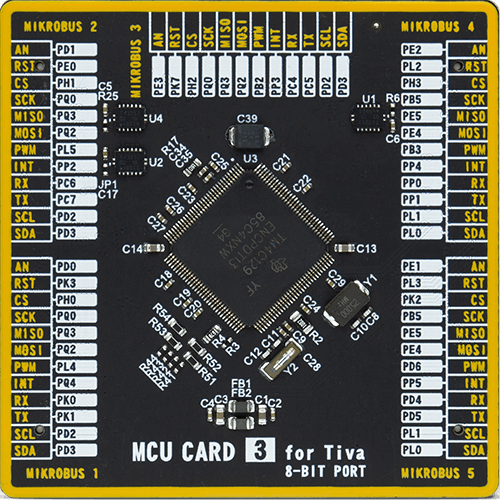
Type
8th Generation
Architecture
ARM Cortex-M4
MCU Memory (KB)
1024
Silicon Vendor
Texas Instruments
Pin count
128
RAM (Bytes)
262144
Used MCU Pins
mikroBUS™ mapper
Take a closer look
Click board™ Schematic

Step by step
Project assembly
Software Support
Library Description
This library contains API for nvSRAM Click driver.
Key functions:
nvsram_send_cmd- The function sends the desired command to the CY14B101J2nvsram_memory_write- The function writes a sequential data starting of the targeted 17-bit memory addressnvsram_memory_read- The function read a sequential data starting from the targeted 17-bit memory address
Open Source
Code example
The complete application code and a ready-to-use project are available through the NECTO Studio Package Manager for direct installation in the NECTO Studio. The application code can also be found on the MIKROE GitHub account.
/*!
* @file main.c
* @brief nvSRAM Click example
*
* # Description
* This is an example that demonstrates the use of the nvSRAM Click board.
* In this example, we write and then read data from nvSRAM memory.
* Results are being sent to the Usart Terminal where you can track their changes.
* All data logs write on USB uart changes approximately for every 5 sec.
*
* The demo application is composed of two sections :
*
* ## Application Init
* Initialization driver enables - I2C, lock Serial Number write, disable Block Protection
* and enable Memory Write, also write log.
*
* ## Application Task
* Writing data to a memory address, then reading it back and logging it onto uart terminal.
*
* @author Stefan Ilic
*
*/
#include "board.h"
#include "log.h"
#include "nvsram.h"
static nvsram_t nvsram;
static log_t logger;
char demo_data[ 9 ] = { 'm', 'i', 'k', 'r', 'o', 'E', 13 ,10 , 0 };
char read_data[ 9 ];
uint32_t mem_addr;
void application_init ( void ) {
log_cfg_t log_cfg; /**< Logger config object. */
nvsram_cfg_t nvsram_cfg; /**< Click config object. */
/**
* Logger initialization.
* Default baud rate: 115200
* Default log level: LOG_LEVEL_DEBUG
* @note If USB_UART_RX and USB_UART_TX
* are defined as HAL_PIN_NC, you will
* need to define them manually for log to work.
* See @b LOG_MAP_USB_UART macro definition for detailed explanation.
*/
LOG_MAP_USB_UART( log_cfg );
log_init( &logger, &log_cfg );
log_info( &logger, " Application Init " );
mem_addr = 1024;
// Click initialization.
nvsram_cfg_setup( &nvsram_cfg );
NVSRAM_MAP_MIKROBUS( nvsram_cfg, MIKROBUS_1 );
err_t init_flag = nvsram_init( &nvsram, &nvsram_cfg );
if ( I2C_MASTER_ERROR == init_flag ) {
log_error( &logger, " Application Init Error. " );
log_info( &logger, " Please, run program again... " );
for ( ; ; );
}
log_printf( &logger, " Serial Number Lock \r\n" );
log_printf( &logger, " None Block Protection \r\n" );
nvsram_reg_write( &nvsram, NVSRAM_MEM_CTL_REG, NVSRAM_SNL | NVSRAM_BP_NONE );
Delay_ms ( 100 );
log_printf( &logger, " Enable Memory Write \r\n" );
nvsram_enable_memory_write( &nvsram, NVSRAM_WRITE_MEMORY_ENABLE );
Delay_ms ( 100 );
log_info( &logger, " Application Task \r\n" );
}
void application_task ( void ) {
log_printf( &logger, " Write data : %s \r\n", demo_data );
nvsram_memory_write( &nvsram, mem_addr, &demo_data[ 0 ], 9 );
log_printf( &logger, "- - - - - - - - - - - - \r\n" );
Delay_ms ( 100 );
nvsram_memory_read( &nvsram, mem_addr, &read_data[ 0 ], 9 );
log_printf( &logger, " Read data : %s \r\n", read_data );
log_printf( &logger, "----------------------- \r\n" );
Delay_ms ( 1000 );
Delay_ms ( 1000 );
Delay_ms ( 1000 );
Delay_ms ( 1000 );
Delay_ms ( 1000 );
}
int main ( void )
{
/* Do not remove this line or clock might not be set correctly. */
#ifdef PREINIT_SUPPORTED
preinit();
#endif
application_init( );
for ( ; ; )
{
application_task( );
}
return 0;
}
// ------------------------------------------------------------------------ END






















